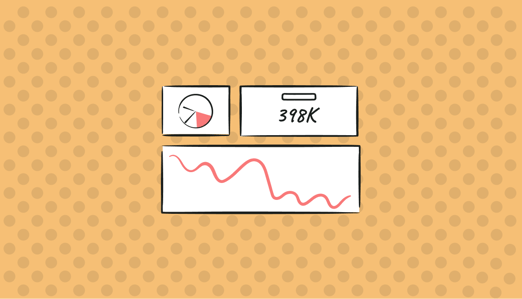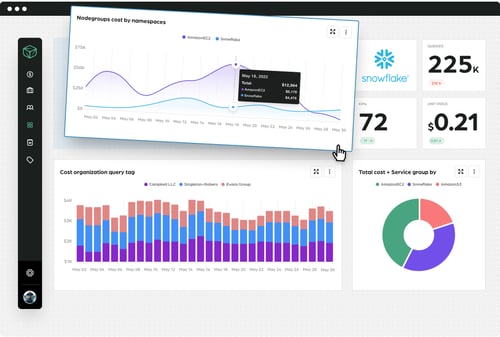
With recent discussions about Snowflake's skyrocketing costs and Instacart's viral IPO report, which revealed they spend more than $50M annually on Snowflake, we believe it's the perfect time to update our Snowflake optimization guide.
Managing Snowflake costs effectively requires more than basic monitoring—it demands a strategic approach supported by advanced FinOps tools. Without the right setup, Snowflake's pay-as-you-go pricing model can lead to unpredictable monthly bills and spiraling costs.
In this article, we'll go through the top seven ways you can reduce your Snowflake spending. But first, let's examine how Snowflake costs are calculated.
What Is Snowflake?
Snowflake is a cloud-based data platform offering services such as data storage, processing, and analytics. Unlike traditional data platforms, Snowflake runs entirely on the cloud and provides a scalable and flexible solution for managing data across various workloads. It’s designed to handle large amounts of data, allowing businesses to focus on insights rather than infrastructure.
Understanding Snowflake Pricing Model
Snowflake’s pricing operates on a pay-as-you-go model, charging for the resources you use. This includes compute costs, storage costs, and data transfer costs. These factors can lead to fluctuating monthly bills, so understanding the cost structure is essential for proper management.
Key Factors Affecting Snowflake Costs
- Compute Costs: The majority of Snowflake costs come from compute resources. These costs are determined by the size and duration of virtual warehouses in use. Efficiently managing warehouse size and operational times can help in reducing these costs.
- Storage Costs: While typically lower than compute costs, storage fees are calculated based on the amount of data stored. Keeping data volumes in check and regularly pruning unnecessary data is vital for cost savings.
- Data Transfer Costs: Moving data between Snowflake regions or external cloud providers can lead to transfer costs. Minimizing unnecessary data transfers is an effective way to cut down on these expenses.
Snowflake Cost Optimization: Understanding Compute, Storage, and Data Transfer Costs
The essence of Snowflake cost optimization lies in grasping how its pricing structure works. Snowflake's costs are largely influenced by three primary factors: compute, storage, and data transfer.
1. Compute Costs: This often makes up the lion's share of your Snowflake expenses. Compute costs are tied to the duration and capacity of your warehouses in use. With warehouses available in sizes from x-small to 6X-large, the price doubles for each ascending tier. Efficiently managing and selecting the right warehouse size can be a significant step towards Snowflake cost optimization.
2. Storage Costs: Generally lower than compute costs, storage pricing revolves around the volume of data you've stashed across tables, clones, and various regions. By regularly monitoring and pruning redundant or outdated data, you can further optimize Snowflake storage costs.
3. Data Transfer Costs: These costs arise when you shuffle data between different Snowflake regions or to an external cloud provider. Strategic planning and minimizing unnecessary transfers can help in optimizing these costs.
In conclusion, a thorough understanding of these elements not only provides clarity on Snowflake's charging mechanism but also illuminates the path to effective snowflake cost optimization. Implementing strategic measures can substantially cut down on unnecessary expenditures.
Snowflake Cost Optimization: Strategies for Efficient Warehouse Management
1. Optimal Warehouse Size Selection
An essential factor in Snowflake cost optimization is choosing the right size for your warehouse. The warehouse size in Snowflake directly correlates with your billing. Tailor your choice based on the use case: utilizing large warehouses for intensive queries and smaller ones for lighter tasks usually yields the most cost-effective results. However, remember that when a warehouse is off, it's free, leading us to our subsequent tip.
2. Auto-Suspend Idle Warehouses
Inactive virtual warehouses can eat into your budget without providing value. Snowflake cost optimization entails ensuring that you're not charged for dormant compute power. The auto-suspend feature comes to your aid here. It's typically on by default, but for greater efficiency, you can minimize the delay post-query execution before a warehouse auto-suspends. Navigate to the 'Warehouses' tab in your Snowflake application and set your preferred suspension time. Also, consider activating auto-resumption, so warehouses reactivate upon receiving a new query.
3. Adjust Default Query Timeout Value
Snowflake's default setup allows statements to run for a lengthy 48 hours (or 172800 seconds) before halting them. Such extended durations can lead to unintentional costs, especially if the query was mistakenly initiated. To bolster your Snowflake cost optimization strategy, tweak the STATEMENT_TIMEOUT_IN_SECONDS parameter. By setting a more reasonable timeout, you can prevent undue charges and ensure optimal resource utilization.
4. Employ Resource Monitors for Credit Oversight
For consistent Snowflake cost optimization, vigilance on credit usage is pivotal. Resource monitors help ensure warehouses halt when credit limits are hit. Pro-tip: Establish multi-tiered credit thresholds, for instance, alerts at 70% and 90% of credit usage. Need an extra credit top-up for your Snowflake account? Consider using a credit card for increased budget flexibility. Alternatively, cloud cost management tools like Finout offer insights into your spending trends and facilitate setting up cost alerts.
5. Divide and Conquer with File Splitting
Mitigate processing overheads by partitioning large files into digestible chunks using a split utility. Distributing loads allows Snowflake to run tasks in parallel threads, simultaneously loading multiple files. The result? Reduced compute time for your virtual warehouse – a simple yet effective Snowflake cost optimization strategy.
6. Implement Alerts for Reader Accounts
Sharing data with non-Snowflake users? Reader accounts facilitate this. However, remember, you foot their usage bill. For proactive cost management, monitor these accounts vigilantly to sidestep unexpected expenditure surges from dormant, yet active, warehouses. Set resource monitors to cap credit usage for these accounts and preempt end-of-the-month financial surprises.
7. Leverage Zero-Copy Cloning for Savings
Zero-copy cloning, a standout Snowflake feature, enables creation of database, table, and schema clones without demanding extra storage. Pointers direct to live data, trimming down both storage costs and the time to set up cloned environments. A crucial pointer for Snowflake cost optimization: If the original table is deleted, storage fees migrate to the clone. To curb unnecessary costs, discard both unused original and cloned tables.
Harness these strategies to navigate your Snowflake expenses adeptly, ensuring efficient resource usage and cost-effective outcomes.
Cut costs without compromising performance
We hope the tips outlined in this article will help you optimize your Snowflake costs. Here's a summary of what you can try:
- Choose the right size of your warehouses
- Suspend warehouses that are sitting idle
- Update the query timeout default value
- Use resource monitors to track credit usage
- Split large files to minimize processing overhead
- Create alerts for reader accounts
- Use zero-copy cloning
All of these methods are easy to implement and revert if things don't go to plan. Just try them out and keep track of their impact on your monthly bill.
And if you ever want to get to the next level and start reducing your cloud spend alongside your entire cloud environment - book a demo with our team today









